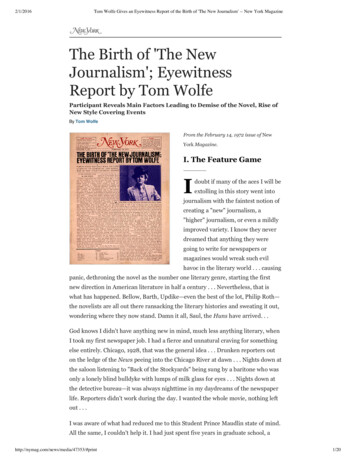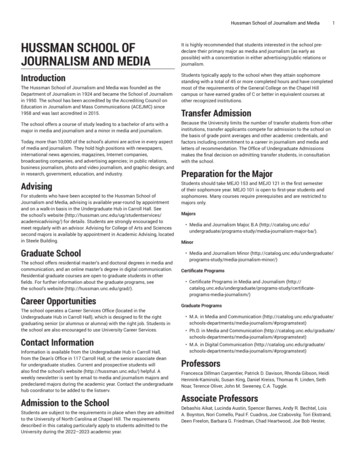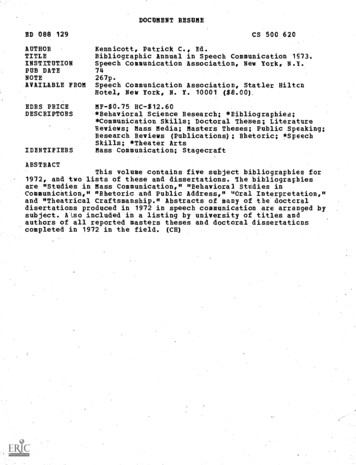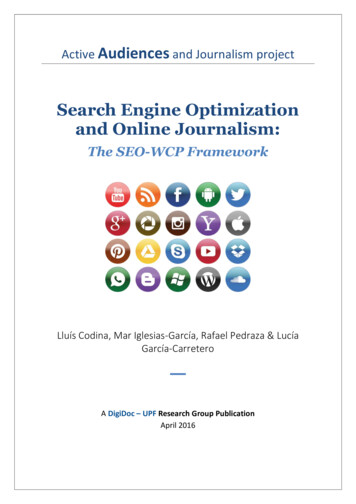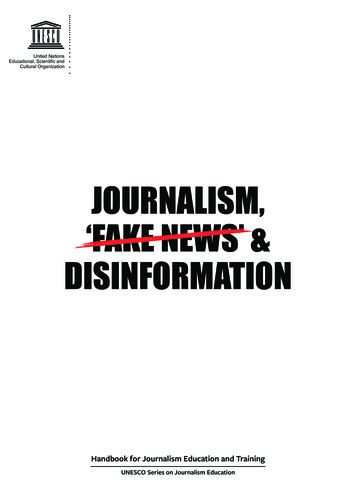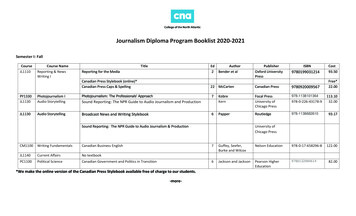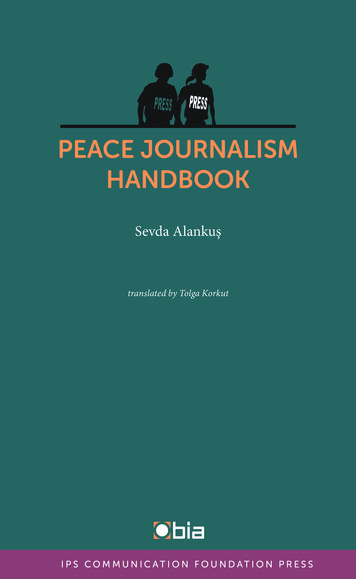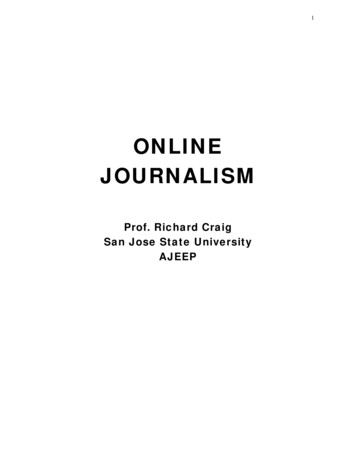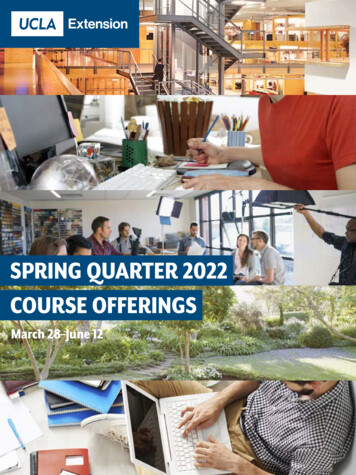
Transcription
EFFECTS OF JOURNALISM EDUCATION ON STUDENT ENGAGEMENT:A CASE STUDY OF A SMALL-TOWN SCHOLASTIC PRESS PROGRAMA Thesispresented tothe Faculty of the Graduate Schoolat the University of Missouri-ColumbiaIn Partial Fulfillmentof the Requirements for the DegreeMaster of ArtsbyTODD R. VOGTSDr. Keith Greenwood, Thesis SupervisorMAY 2018
Copyright by Todd R. Vogts 2018All Rights Reserve
The undersigned, appointed by the dean of the Graduate School, have examined thethesis entitledEFFECTS OF JOURNALISM EDUCATION ON STUDENT ENGAGEMENT:A CASE STUDY OF A SMALL-TOWN SCHOLASTIC PRESS PROGRAMpresented by Todd R. Vogts,a candidate for the degree of master of arts,and hereby certify that, in their opinion, it is worthy of acceptance.Dr. Keith GreenwoodDr. Ronald KelleyDr. Jill OstrowProfessor Anna Romero
DEDICATIONTo my wife Kendall, my daughter Presley, and the rest of my family and friends for theirsupport and encouragement.
ACKNOWLEDGEMENTSI would like to thank Dr. Keith Greenwood for his help and guidance on thisproject. His insights were invaluable as I attempted to navigate all the parameters such aresearch endeavor presents. Likewise, I appreciate the feedback my committee membersprovided along the way. The served as critical eyes in helping make sure all theinformation presented was solid.I would be remiss if I didn’t thank the educators at Canton-Galva High School.Principal Shawn Koehn graciously allowed me access to the students, and journalismteachers Cara Duell and Tina McMannis welcomed me into their classrooms. They werewilling to allow me to pull students out of class to interview them, and they never oncevoiced a concern about the instruction or work time the students were missing whilespeaking with me. Also, thank you to all the students. They answered my questionswithout hesitation, and they were not bothered by my presence in the classroom. Theymade it much easier for me to complete this study.ii
TABLE OF CONTENTSACKNOWLEDGEMENTS .iiChapter1. INTRODUCTION . 1Research Problem . 2Research Purpose . 3Research Questions . 4Explication of Concepts. 62. LITERATURE REVIEW . 9Social Capital in Society. 10Pedagogy and Application of Journalism Education . 14Academic Engagement . 19Social Engagement . 21Civic Engagement . 253. METHODS . 33Validity of Methodology . 34Methodology . 36Analysis, Ethics, and Credibility. 37Defining Engagement . 40Similar Studies . 424. RESULTS . 47Inside the Publications . 50Impact on Students . 675. CONCLUSIONS . 95Findings . 96iii
Significance. 104Limitations . 112Directions for Future Research . 113Recommendations . 115Final Thought . 117REFERENCES. 118APPENDICES . 131List of Questions for Students. 132List of Questions for Advisers . 134iv
EFFECTS OF JOURNALISM EDUCATION ON STUDENT ENGAGEMENT:A CASE STUDY OF A SMALL-TOWN SCHOLASTIC PRESS PROGRAMTodd R. VogtsDr. Keith Greenwood, Thesis SupervisorABSTRACTUsing social capital theory as the lens, this case study investigates how being part of ascholastic journalism program impacts the academic, social, and civic engagement levelsof students in a small-town, rural setting by observing and interviewing journalism staffmembers at Canton-Galva High School in Canton, Kansas. Two journalism advisers andeight journalism students were interviewed, and observations took place during theSpring 2018 academic semester. The students were part of either the bi-weekly newsmagazine or the yearbook. Concepts of media literacy and pedagogical practices of thejournalism advisers were also explored. Though the results cannot be generalized toencompass the experiences of students in all high school journalism programs, the studyfinds Canton-Galva High School students, who are experiencing increased academicengagement, fail to engage socially or civically directly as a by-product of participatingin the journalism program largely due to weakness in pedagogy of the journalism courses.Students are increasing their social capital, though, by being exposed to tenets of socialand civic participation.Keywords: scholastic journalism, engagement, social capitalv
Chapter 1: IntroductionIn April 2017, the Booster Redux, the student newspaper of Pittsburg High Schoolin southeast Kansas, made national headlines. This stemmed from a report the studentjournalists published questioning the credentials of a newly hired district administrator(Schmidt, 2017). The students found principal Amy Robertson’s master’s degree anddoctoral degree came from the unaccredited and possibly nonexistent Corllins University(Chappell, 2017). Four days after publishing the report, Robertson resigned (Mele, 2017).Throughout the reporting process, the students were told to stop pursuing it becauseRobertson had been properly vetted by the school board, the superintendent, and a hiringcommittee, which even included the Pittsburg High School journalism adviser (Schmidt,2017).The story started out as a simple profile on the newly hired principal, but then thestudents uncovered the discrepancies. Outside of the questions concerning her advanceddegrees, Robertson also claimed to have received her bachelor’s degree in fine arts fromthe University of Tulsa, but after checking into it, the students found Tulsa does not evenoffer such a degree (Mele, 2017). Even working over spring break, the students spentweeks reporting the story and raising questions with the superintendent, who continuallyassured the students Robertson was qualified and would be a good principal (Morrison,2017). The pressure on the students was undoubtedly intense. Having never pursued sucha story, the students sought advice from the executive director of the Kansas ScholasticPress Association, and they made the decision to publish the story (Schmidt, 2017). Theywere further bolstered by the Kansas Student Publications Act, a law “which grantsstudents independent control over their editorial content, including material that might1
paint a school in an unflattering light” (Mele, 2017, n.p.). The students even beat the localpaper, the Pittsburg Morning Sun, to publishing the expose over Robertson (Chappell,2017). Had she not resigned, Robertson would have received a 93,000-a-year salary(Morrison, 2017).Research ProblemWhat happened in Pittsburg demonstrates the important role high schooljournalism can play, even in small-town, rural Kansas. If it were not for the studentsquestioning the credentials of a newly hired administrator, an unqualified person wouldhave been in charge of an educational institution. Though not every high schooljournalism article carries enough power to unseat an administrator, the work studentjournalists do is equally as important as they shed light on important issues students face,whether it be something less controversial like test anxiety or something as unsettling asrape. Without a journalism program, such newsworthy topics would go unreported.With Kansas riding a wave of national attention for its student journalism, it raisesquestions about what other programs are doing to produce quality journalism. WhilePittsburg High School journalism would seem to be doing exceedingly well, whatCanton-Galva High School journalism faces presents a more problematic issue as itrelates to the program’s longevity. Located in rural, central Kansas, Canton-Galva HighSchool had an enrollment of 98 students during the 2016-2017 school year (2016-2017Classifications and Enrollments, 2016), and had an enrollment of 108 students for the2017-2018 school year (2017-2018 Classifications and Enrollments, 2017). Thecommunity is largely comprised of white, middle class, and conservative individuals. Theschool district consists of two communities — Canton and Galva — located 11 miles2
apart. Through the 2016-2017 academic school year, the journalism program hadproduced a yearbook, a monthly magazine, and a website. That changed for the 20172018 school year. Longtime adviser Jessica Bowman, who had led her program tomultiple state awards, left to teach at another school. Instead of hiring a replacement forBowman, the journalism duties were shifted to two other teachers already in the building— Tina McMannis and Cara Duell. This resulted in the elimination of the printedmonthly magazine in favor of a digital-only, bi-weekly news magazine and the shutteringof the website. Essentially, this change in staffing resulted in the elimination of twojournalistic outlets for the program and created a new one.In small-town schools, the attention of students is pulled in numerous directions.Everyone is expected to help the school by being involved in as many things as possible.The athletics teams need players, the school play needs actors, the academicorganizations need members, the band needs musicians, and all the students havehomework and, often, work schedules thrown into the mix as well. This all spreads thestudents thin, and journalism is not always the first choice for most students due to thenature of the work or reputation of the program. Having only one physical journalisticproduct can further reduce the appeal of being a part of the program as opportunities forrecognition for the work being done become rarer.Research PurposeWith engagement being defined “as a collection of experiences” (Mersey,Malthouse, & Calder, 2010, p. 39), the purpose of this research is to explore levels ofacademic, social, and civic engagement of the students living in a digital age who areinvolved in a small-town, Kansas journalism program. Such a study is important because3
a lot of research concerning high school journalism focuses on large, urban schools. Thisleaves out rural journalism students. Furthermore, this research adds to the scholarship onthis topic because most studies look at larger, more metropolitan high schools wheninvestigating different forms of engagement. Instead, this study looks at a school in amore rural setting with smaller student populations. It is hoped that through such a studythe validity of journalism at small schools can be increased. Too often it seems the focusis only on the larger schools with the money to have seemingly unlimited resources.Small schools can produce great journalism too, and they often do so with much less interms of funding and support. Also, not many studies focus on Kansas, instead opting formore generalized nation-wide surveys of the prevalence of journalism education andimpacts of ethnicity and socioeconomic factors on journalism programs (Amster, 2006;Dvorak, Bowen, & Choi, 2009; Dvorak, Lain, & Dickson, 1994; Marchi, 2012).To observe operation of the class and its results, a case study was combined within-depth interviews. Interviews afford the opportunity to gain insights concerning theexperience the students and advisers are having.Research QuestionsA lot of the research concerning scholastic journalism tends to focus on largerschools in more metropolitan areas (Amster, 2006; Bobkowski, Goodman, & Bowen,2012). Missing from this strand of research is focused inquiry into rural and small-townhigh school journalism programs. To contribute to the broader body of knowledgeconcerning scholastic journalism and using social capital theory, this study sought toexplore how journalism is taught in smaller schools as a way to increase academic, social,and civic engagement.4
RQ1: How are journalism programs structured to support engagement? Thestructure of a high school journalism program can vary from location to location. Someprograms operate with more student control, while others put the adviser in charge ofmany aspects of the student publications. This relates back to the social norms and valuesof the community in which the program operates. School administrators are oftenreluctant to give student journalists too much leeway to preserve the public image of theschool district. However, such actions can dampen student engagement.RQ2: How are student journalists given opportunities to engage socially andcivically? Scholastic journalism programs provide students the chance to practicejournalism. This can be done by producing an annual yearbook, a monthly newspaper ormagazine, or a more frequently produced broadcast or website. Beyond this, though,student-produced media can be platform for expression. Also, the students’ involvementcan result in connections being made with social and civic organizations that could leadto larger engagement opportunities.RQ3: Based upon the perceptions of the students, to what extent do highschool journalism advisers influence student engagement? Educators can be hugelyinfluential in the lives of youth. A journalism student’s interest in social and civicendeavors can be sparked by time spent in a classroom with a particular teacher. Agovernment teacher would be an obvious possibility for this kind of inspiration, butjournalism deals with social and civic issues on a daily basis. The hands-on exposure tosuch aspects of life might have a significant impact on a student’s thoughts and opinions.RQ4: What curricular components are incorporated to teach students theirrights and responsibilities? Journalism is not taught uniformly from school to school.5
Therefore, student exposure to First Amendment Law education might be limiteddepending upon the school district, the program, and the adviser. To effectively engagesocially and civically, students need to know their rights. Key to this is a curricular focuson media literacy. Such education can help students understand the media landscape andknow how to sort through the online noise. With increased media literacy, impacts ofphenomena such as “fake news” can be reduced.RQ5: How is technology, such as social media, used in the program toamplify students’ voices? Social media is an equalizer. Regardless of personal resourcesor physical location, people can connect and share ideas with incredible ease.Collaboration can happen in an instant. Thanks to mobile devices, people are alwaysavailable on social media, and the platforms have been used to organize movements, suchas what took place during the Arab Spring (Davison, 2015). Social media can also bebeneficial to engaging audiences, which is a skill journalists need in the professionalrealm. Scholastic journalism programs present the opportunity for students to learnmultiple skills with and uses of social media and other technologies.By considering these research questions, a clear picture of how high schooljournalism programs support social and civic engagement is drawn. By looking at a morerural setting, important understanding of a less-often considered and represented segmentof the population is gained.Explication of ConceptsJournalism education is important for a democratic society because studentsinvolved in scholastic journalism “follow and engage with important community issuesand that by informing their audiences about these issues, they perform civic service and6
learn to effectively contribute to the civic process” (Bobkowski & Miller, 2016, p. 530).Furthermore, journalism education allows for students to focus on service learning, whichis a pedagogical concept relating to developing self-efficacy as part of the doing processand becoming a member of a democratic society by developing a value for participation(Ball, Procopio, Goering, Dong, & Bodary, 2016). The value of journalism education isextended into more academic realms by the fact students involved in scholasticjournalism consistently perform higher when judged against standard testing practices(Dvorak, Bowen, & Choi, 2009; Roschke, 2009). In journalism programs, students aregranted the opportunity to increase psychological processes of memory and learning bybeing allowed to practice the skills being taught in a real-world setting of producingjournalistic content (Morgan, Shanahan, & Signorielli, 2015). Social engagement,specifically relating to media literacy and understanding of messaging, is increased whenstudents are involved in journalism programs (Marchi, 2012). This is important because“mass-produced messages form the culture” of our society “and thereby shaped publicknowledge and beliefs over the long term” (Potter, 2014, p. 1,017). Furthermore, studentsexposed to journalism education show more understanding and participation with politicsat all levels (Bobkowski, Goodman, & Bowen, 2012). Journalism programs also allowstudents to become socialized in three of four aspects of public life, which are family,school, media, and peers (Shah, McLeod, & Lee, 2009). With fewer opportunities to beinvolved in journalism, the levels of engagement by the students could be negativelyimpacted.With the technology currently available in today’s society, students have more ofthe world at their fingertips than ever before. This would seem to indicate high school7
students would be more adept at engaging with others and being more open to peoplewith differing viewpoints and backgrounds. After all, social media connects people fromany distance, and younger people are highly connected on social media (Greenwood,Perrin, & Duggan, 2016). However, it has been suggested that students might be moreantisocial due to social media because they would rather engage with others in a digitalspace rather than face-to-face (Sass, 2016). This is akin to Putnam’s (2001) research ofsocial capital theory, in which he found the widespread use of television by the public ledto a decline in social and civic engagement. However, since social media is a two-waycommunication tool, unlike television, the potential positives for using social mediaoutweigh the negatives. High school journalism programs and the engagement levels ofthe students on staffs are benefited by putting a focus on digital reporting tools, such associal media or websites. After all, being able to develop social capital through ajournalism program helps to “stress the importance of community involvement to sustaindemocracy” (Zhang & Seltzer, 2010, p. 156).The next chapter presents a review of the literature relevant to the study, includingan overview and explanation of theory and introduction of prior research that informs theapproach to this study. An explanation of and rationale for the methods used is presentedin chapter three. The results of the study, including insights from the study’s subjects andobservations of the operation of the journalism program, are presented in chapter four.Finally, chapter five presents the conclusions reached as a result of the study and suggestswhy the study was important and where further research should focus.8
Chapter 2: Literature ReviewNelson Mandela said, “Education is the most powerful weapon which you can useto change the world” (as cited in Strauss, 2013). When it comes to learning, one type ofeducation stands out — journalism education. For society to benefit and positive impactsto be made, students must understand how to navigate the media landscape and interactwith the world around them. Participation in journalism programs provides uniqueopportunities to practice being a citizen before fully embarking into full societalcontribution. Presidential elections might only happen every four years, but with eachhigh school graduating class, newly minted adults enter society. These former studentscan continue to be students or simply enter the work force. With proper education andexperiences, what they do with their rights and responsibilities as citizens and membersof society can result in positive change, regardless of the scale to which the impact isimparted.Students have First Amendment rights, despite what some administrators or otheradults may believe (LoMonte, Goldstein, & Hiestand, 2013). It is the job of educators, atall levels, to teach skills and knowledge associated with journalism so that power iswielded properly. Instructors must be advocates for student journalists and practice soundadvising techniques that protect those rights and allow student journalists to function asprofessional journalists, even if administration pays for a portion of the publication costs(Kopenhaver, 1984). Methods of instruction vary, but the goal of developing futurejournalists holds true for the majority of educators. This is particularly important in aworld of ever-changing technology. Educators must adapt to give students the skillsneeded in the current employment marketplace (Briggs, 2007). However, if the students9
are part of a minority race and the income of their parents is low, the education receivedcan be affected (Amster, 2006). Furthermore, students exposed to journalism educationshow more understanding and participation with politics at all levels (Bobkowski,Goodman, & Bowen, 2012).Research in journalistic education is varied. Some studies look at pedagogy(Dailey, 2016; Tuggle, Sneed, & Wulfemeyer, 2000). Others look at the students’abilities to find jobs after graduation (Becker, Jeong Yeob, Wilcox, & Vlad, 2014). Also,studies look at how technology is playing an ever-increasing role in journalism education(Grabowski, 2014). Implications of journalism education on civics also show up (Clark &Monserrate, 2011; Clark & Monserrate, 2018). Continued research in the area ofjournalism education is important because of budgeting concerns at learning institutionsand changes within the journalism industry that require journalists entering the field tohave new and varied skills. Scholastic journalism programs exist to help train futurejournalists, so keeping apprised of changes in school systems and the professional realmproves necessary.Social Capital in Society“[S]ocial capital is the nutritive tissue from which civic organizations andcollective action grow” (Matei, 2003, p. 6). Putnam (2001), a recognized leader on thesubject, suggests social capital is a web of mutual trust and cooperation derived from theparticipation in community groups and organizations. Putnam’s research led him to seehow social capital as he defined it is a crucial component for social and civic engagement(Maras, 2006). Putnam (2001) saw a decline in social capital by noticing fewer peoplewere joining bowling leagues and other community organizations, which he attributed to10
increased television consumption. The issue with television consumption, as someresearch suggests, is that it can cause viewers to be desensitized, especially to societal illssuch as poverty or violence (Edgar & Edgar, 1971). This can lead to a less civil society,which can negatively impact democracy functioning properly (Putnam, 2001). Suchimpacts can be attributed to less knowledge being available due to the lack of theprescribed engagements (Edgar & Edgar, 1971). Without this knowledge, which isimportant for being active in a democracy, reasons to become civically engaged dwindlebecause the idealism, instilled responsibility, and enjoyment of political participationbecomes nonexistent (Putnam, 2001).With the increase of Internet connected devices and social media use, less socialcapital could be developed, especially with younger generations. The primary cause ofthis could be time displacement in that users are more engrossed in their digital lives thanthe social and civic opportunities presented around them (Maras, 2006). The research onthis, however, is not in complete agreement. Some scholars believe “on-line communitieswill make possible new social arrangements, more democratic and more inclusive,” whileothers believe “social groups facilitated by the computer revolution will, in fact, destroytraditional social bonds, leading to weak social ties” (Matei, 2003, p. 3). These forms ofdigital and online engagement are a form of mass media. Therefore, the two sides of theacademic theory are worth considering because a society’s culture is formed andinformed by the mass media consumed as it shapes public knowledge and beliefs (Potter,2014).As such, to develop a society with more social capital, the education high schoolstudents receive should be considered. For instance, a high school journalism program11
gives students the opportunity to develop psychological processes of memory andlearning needed to be more productive members of society (Morgan, Shanahan, &Signorielli, 2015). Furthermore, such an education allows students to develop key skillsto having a successful public life, such as learning to interact with school, media, andtheir peers (Shah, McLeod, & Lee, 2009).However, not all high school journalism programs are the same, especially whenconsidering available resources such as funding or curriculum. Most research focuses onlarge programs, overlooking smaller ones, but the smaller, rural schools may be playing apart in local information that’s being overlooked. Despite the digitally connected worldsociety currently exists in, “most journalism continues to serve audiences closer to home”(Hess, 2015, p. 482). Gilbert, Karahalios, & Sandvig (2010) suggest rural communitiesare those with less than 2,500 people, consist of large swaths of farm ground, and “tendto be older, less educated, less wealthy, and less mobile than urban Americans” (p.1,370). Local media, then, plays an important role in connecting and informing thecommunities it serves, and the reading of local print products is pointed to as being anindicator of having higher levels of social capital (Hess, 2015; Maras, 2006). High schooljournalism often fills the role of local news provider in small, rural communities, so astudent-produced newspaper helps keep the local populace informed. Print journalismhelps climate the feelings of social and geographical isolation that rural residents canexperience (Gilbert, Karahalios, & Sandvig, 2010). Such isolation could contribute to thefact television and other media privatized leisure (Putnam, 2001). The effects of whichcould be more impactful in rural areas because there is less to do and television viewingin one’s own home is more convenient (Maras, 2006). However, even though access in12
rural areas can be an issue, rural individuals seem to adopt new technologies quitereadily, which could be due to a desire to minimize isolation (Gilbert, Karahalios, &Sandvig, 2010).Therefore, print products and the use of emerging technologies in a rural schoolare important considerations. This is especially true due to social media allowing variousindividuals to connect over any distance, and younger people use social media at highlevels (Greenwood, Perrin, & Duggan, 2016). Even so, rural social media users tend toconnect with those closer to themselves geographically (Gilbert, Karahalios, & Sandvig,2010). Using technology to increase engagement then suggests possible drawbacks forrural students due to rural communities being more focused on a print product. It can be aclash of social norms that can hinder the development of social capital because it issuggested that students have become more antisocial due to their preference to be onsocial media instead of interacting with others offline (Sass, 2016). With social capitalbeing a strong indicator of engagement and technology possibly disrupting this (Putnam,2001), social capital serves as the best lens through which to inspect the work
doctoral degree came from the unaccredited and possibly nonexistent Corllins University (Chappell, 2017). Four days after publishing the report, Robertson resigned (Mele, 2017). Throughout the reporting process, the students were told to stop pursuing it because Robertson had been properly vetted by the school board, the superintendent, and a .

